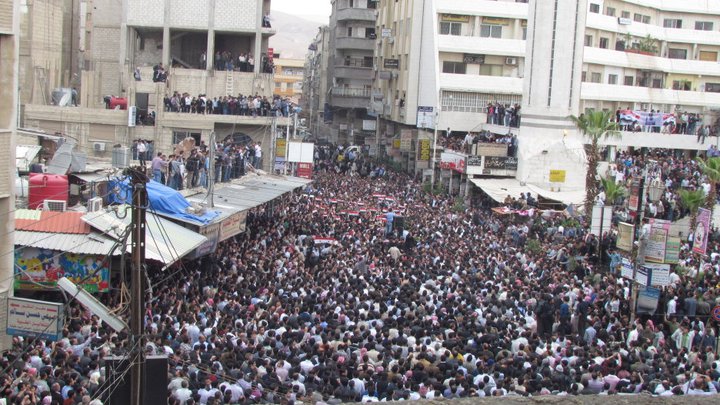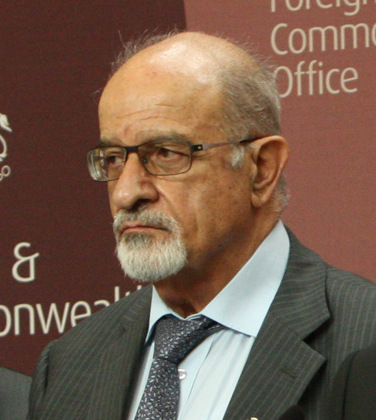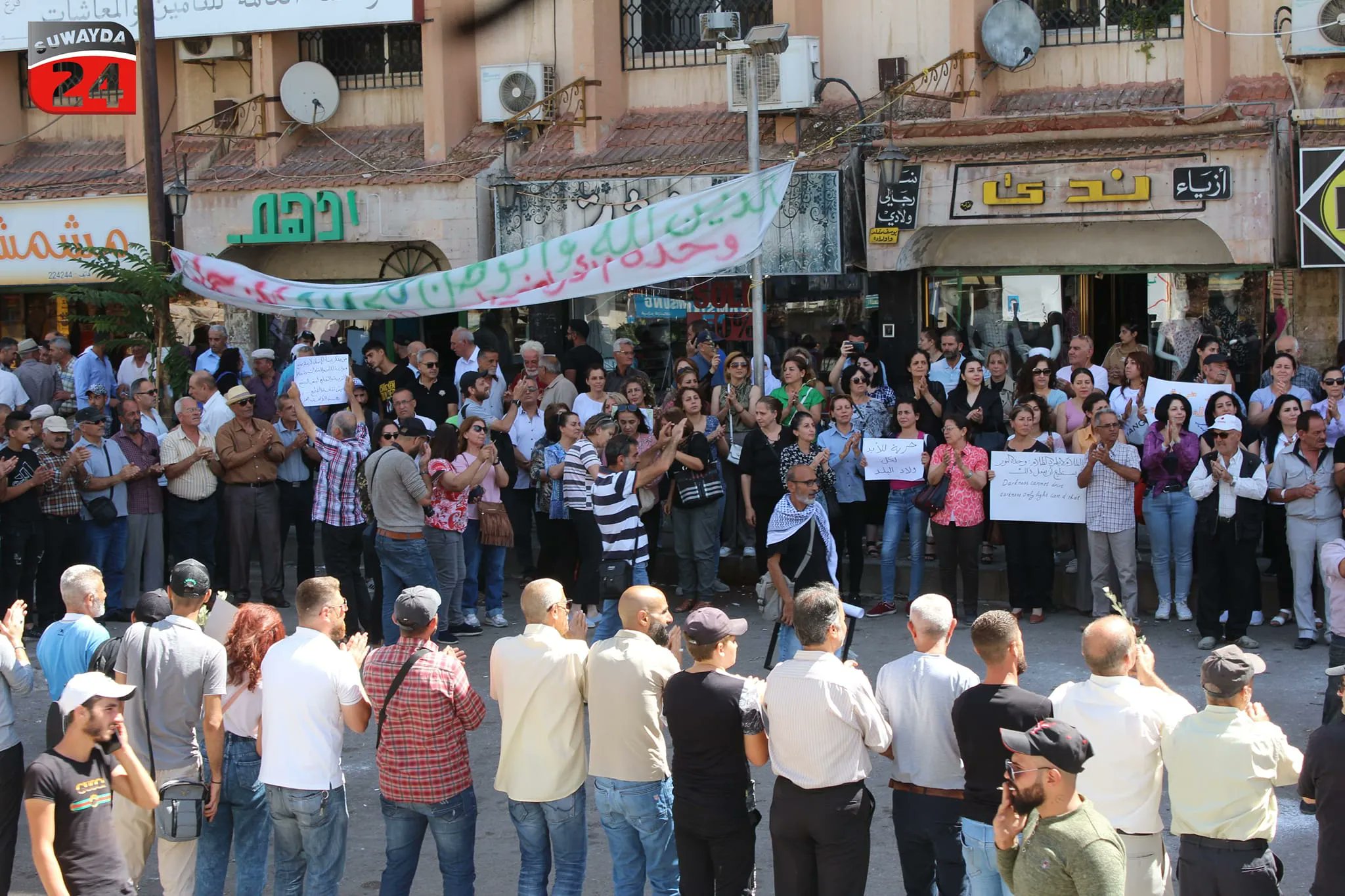On 16 August, the Syrian regime issued a new resolution to deepen the suffering of the Syrian people, 80 percent of whom live below the poverty line, by increasing fuel prices by up to 200 percent. This decision has led to a reduction in purchasing power such that many Syrians are unable to even buy bread. It was the straw that broke the camel’s back, and pushed the poor in Syria to start to take to the streets after a long period of inactivity.
A strike began several weeks ago in the Sweida governorate in southern Syria, which completely paralysed daily life. Demonstrations peaked in the second week to include thousands of participants. The start of these demonstrations sparked protests in other Syrian cities such as Daraa, Idlib, Deir ez-Zor and Aleppo.
The protests remain concentrated in the Sweida governorate. In this province, 95 percent of the population are made up of the Druze religious minority, who did not participate significantly in the protests of 2011 due to the role played by the liberal (secular and Islamic) leadership, represented by the Syrian National Council, and later the opposition coalition. This leadership was backed by imperialism, and acted as a tool to advance the imperialist agenda inside Syria.
The consequences of the imperialist intervention in Libya, Iraq and Afghanistan still haunt the minds of the masses. Demands for foreign intervention were raised from the first months of the revolution. The Assad regime was easily able to exploit these demands, taking into account the popular anti-imperialist mood of the majority of the Syrian people, as well as the fears of religious and ethnic minorities, and fear of the penetration of jihadists – which actually happened later. These tactics are still being used today to cut across the class struggle.
The class struggle between 2011 and 2023
 In 2011, the movement in Syria was influenced by the revolutionary tide coming from neighbouring countries / Image: syriana2011, Wikimedia Commons
In 2011, the movement in Syria was influenced by the revolutionary tide coming from neighbouring countries / Image: syriana2011, Wikimedia Commons
In 2011, the movement in Syria was influenced by the revolutionary tide coming from neighbouring countries. But even if the ‘Arab Spring’ had not broken out, revolution would have broken out in Syria eventually, because of the capitalist measures that Bashar al-Assad adopted since he came to power in 2000 of liberalising the market and privatising the economy. These measures destroyed a lot of state-run industries that were providing jobs. Ten years after the adoption of these measures, agriculture and industry collapsed.
In 2011, the first demonstrations started in informal residential areas, located on the outskirts of cities. These areas were inhabited by victims of the capitalist policies of the regime, people who left the countryside because of the loss of their source of income, but who at the same time cannot afford to live in big cities. However, due to the absence of any revolutionary leadership, the class struggle in 2011 was smothered, and limited to one slogan: “the people want to overthrow the regime.”
Now, the situation is different. Following the experience of defeat, political demands are starting to be combined with economic demands. Over the past 12 years, class consciousness has advanced among the masses in Syria, which has become visible on the slogans raised at the recent protests. Protesters held banners reading: “the suffering of Syrians is the same: tyranny, poverty, unemployment”; and, “the good of my country is my right and the right of my children.” Other banners called for the exit of all imperialist occupiers from Syria. The slogan was clearly: “no to the Turkish, Russian, Iranian and American occupation: all means all.”
Another important thing that distinguishes this protest is the significant presence of women in the front ranks. One of the participants held up a sign that read: “I didn't give birth to my son to abandon him”, expressing the fact that millions of Syrian youth are now forced to travel due to unbearable economic conditions. Notably, in the city of Tartus, a pro-Syrian regime event was organised. The organisers of this event drove their luxury cars through the streets of the city of Tartus with pictures of Bashar al-Assad. Meanwhile, anti-regime demonstrations are carried out by the poor.
The counter-revolution is on the streets again
The class lines in society are becoming clear on the streets, but the problem so far is that there is no organisation capable of galvanising the interests of workers, peasants and the poor. As a result, the masses are still under the influence of religious, ethnic, nationalist and reformist currents. This has also led to a clear rise of counter-revolutionary forces seeking to exploit the mood.
Haitham Al-Maleh, known for his affiliation with the Muslim Brotherhood, published an announcement calling for a demonstration. We stand against the Muslim Brotherhood and any call issued by them, not because they are Muslims, but because they are a reactionary political organisation who have nothing in common with the interests of the Syrian people or their demands. They served as a loyal opposition in the past, and played a counter-revolutionary role throughout the Middle East after 2011.
 Haitham Al-Maleh, known for his affiliation with the Muslim Brotherhood, published an announcement calling for a demonstration / Image: محمد الفلسطيني, Wikimedia Commons
Haitham Al-Maleh, known for his affiliation with the Muslim Brotherhood, published an announcement calling for a demonstration / Image: محمد الفلسطيني, Wikimedia Commons
The Muslim Brotherhood is opposed to the ruling elite for now, but they are not opposed to the capitalist system. They are terrified of the possibility of the movement developing in the direction of overthrowing the regime, and they are keen to keep it within ‘acceptable limits’. This explains their manoeuvres to hijack the protests.
On the other hand, the religious leadership of the Druze community also issued a statement raising demands for superficial reforms to the government, the security apparatus and the police. The leading Druze body consists of a three-person committee. Two of them issued the statement, and the third did not sign it, then went to adopt the demands of the protesters, namely Sheikh Hikmat Al-Hijri.
These demands, which are not unified and do not yet constitute a clear programme, having spontaneously emerged from the protests, include: restore the fuel subsidies, overthrow the Syrian regime, release the detainees, and implement International Resolution 2254.
This latter demand (opportunistically adopted by the Stalinist party ‘Popular Will’) reflects the immature character of the present movement. It stipulates the formation of a government consisting of representatives of the regime, the opportunist opposition and civil organisations. In other words, the three groups that destroyed the Syrian revolution of 2011. There can be no illusions in any of these ladies and gentlemen.
The rise of Islamist movements in Syria in the last decade has caused religious minority groups to become more insular. In the absence of a class-based leadership to cut across sectarian divisions, the protesters in Sweida have pushed forward Sheikh Hikmat Al-Hijri as their leader. For their part, liberal oppositionists have also appeared on the street. They put forward their usual ‘solutions’ in several forms, one of which is foreign military intervention.
What is to be done?
The movement is still developing spontaneously. The leadership is for now limited to religious figures, which only a few weeks ago were part of the Syrian regime. The absence of a revolutionary organisation to provide leadership has led to the rise of reformist and reactionary currents on the street, and the isolation of demonstrations within the Sweida governorate.
What we are witnessing is the very early signs that the Syrian masses are starting to move once again, after the enormous trauma of the counter-revolution and imperialist war that destroyed their homes, livelihoods and living conditions. For now, these green shoots of class struggle are divided and cut across by all manner of reactionary trends. This is only to be expected, given the utter absence of any sort of class-based party or organisation giving the masses a lead.
If the terrible defeats of the past are to be avoided in the future, then the Syrian masses can only trust their own strength. Organisations of struggle must be built from the ground up, and a programme of radical economic and social demands promulgated that can tap into the mood in society, drawing in the whole of the poor and exploited layers, overcoming superficial ethnic and religious lines. Absolutely no faith can be placed in the so-called ‘liberal’ opposition, who are nothing but imperialist stooges. Meanwhile, the forces of religious obscurantism must be countered with a clear, class-based programme.
Ultimately, only building a revolutionary communist party with an internationalist perspective, capable of leading the masses in victorious combat against the regime and all the forces of imperialist and religious reaction, will offer a road out of the quagmire of war, chaos and poverty.
The development of the next chapter of the Syrian revolution will not proceed in a straight line. There will be ups and downs, advances and retreats. Allied with their class brothers and sisters of the region, the Syrian masses will renew the fight for communism and freedom in the whole of the Middle East and North Africa.

